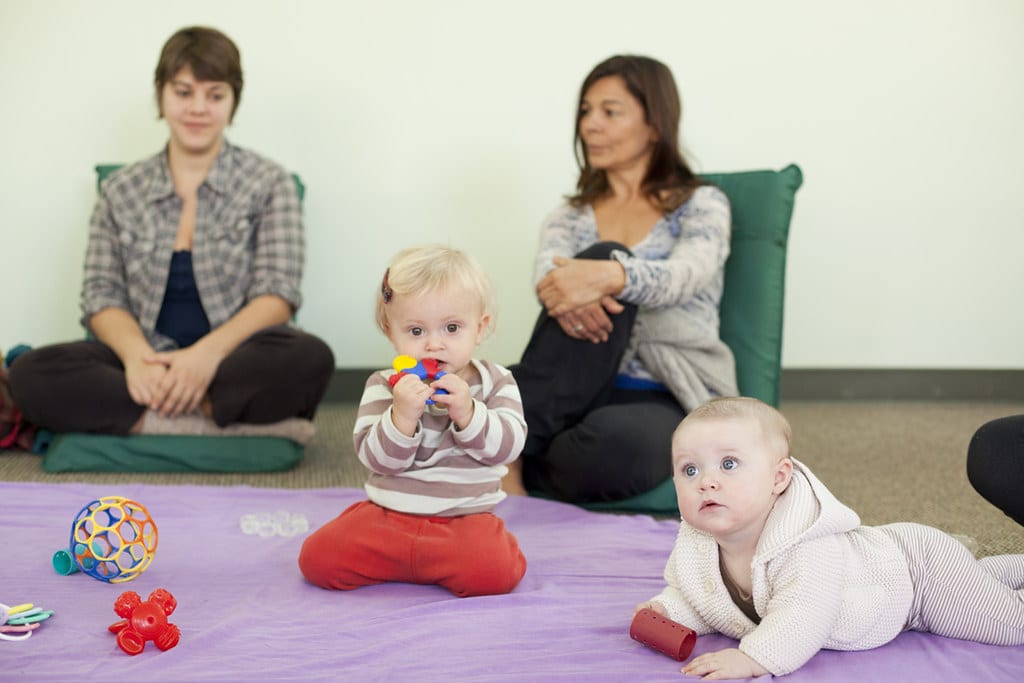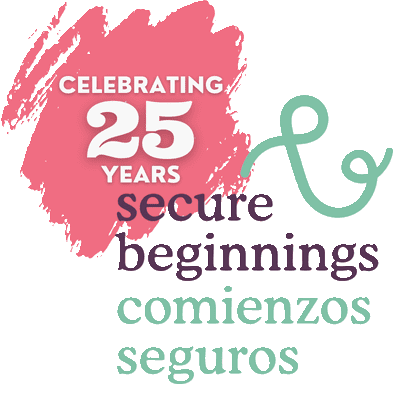
Practicing Observation
written by Terra Solecki, Secure Beginnings Core Class Facilitator
“Do less, observe more, enjoy most!”
– Magda Gerber, founder of Resources for Infant Educarers (RIE)
Each Secure Beginnings class begins with a period of quiet observation. We invite families to settle into a comfortable place in the room. For children it is a time to explore, to go out far or to stay near, to take in the room with their eyes, ears, hands, feet, and mouths. Caregivers have a task as well, to practice active observation.
Caregivers practicing active observation are calm and present. Active observers are fluid in their involvement. One father watches the frustration of his two-year-old son while trying to stack cups, but waits to assist and finds his son solves the problem on his own. A grandmother watching her ten month old granddaughter realizes that reaching for a toy is becoming too stressful, and inquires about help before bringing the cup closer. A mother comes close while her daughter climbs up high, and checks in to see if her daughter needs her help to come down. There is no judgment or assumptions being made. These caregivers are watching and waiting, waiting, waiting to see what their children are doing and what they need. Observation is about nurturing a child’s competence through a waiting and watchful eye, but is also about the caregiver and child partnership.
This kind of observation is not passive, the way the word observation itself seems to suggest. Active observation takes focus and mental effort, creates an amazing connection between you and your child while he plays, and yet allows your child to explore and create completely of his own initiative.
Active observation forces you to wait and watch. How does your child manipulate a new object for the first time? Given a room full of toys, what does your child choose to go to first? Observation forces you to take a step back. There is something amazing about getting to play the teacher to a pupil so eager and inquisitive, but it is equally amazing to watch your child explore and learn on his own. He may find a way to open that container in a completely different way than you would have ever thought to show him or may not open the container at all. This is not to say that while observing you cannot be involved at all. Active observation necessitates that you be involved, but with a mindful eye toward process and not product. A child’s choice is often different than the adult, child centered opposed to adult directed.
By giving your child your full attention you are staying present, ever ready to provide a stable base which they can return to either physically or simply with a reassuring glance from across the room. Your child bonks her head on the table as you are observing her play. She begins to seek you out and you are immediately there, whether she needs a hug and an explanation of what happened, or just that reassuring glance.
Your non-judgmental presence honors and respects who your child is while they play. Being seen is a powerful validation of who we are, even for an infant or young child. Although it is difficult, simply observing what you see and feel, while holding off from making interpretations about what they are doing makes it ok for your child to just be who they are. The back door is open on a hot day, and your child stops right in front. You are five steps ahead of where your child is. It is time to be inside. You take a big breath and just observe. You say to your child just what you see “The back door is open today. Today it is very hot.” Staying in the moment stops and calms grown-ups while helping a child regulate impulses.
While you learn more about your child through observation, you may find that you are also observing yourself. How do you feel the pain when your child bonks their head? What is it about your child reaching for another child’s toy that has your gut in a knot? Knowing yourself may help you to react to situations in a way that is genuine to your child, and is not based on your own fears and anxieties.
Active observation is not easy. It requires focus, energy, a surprising degree of self-reflection, and is simply not feasible to do all day. Setting aside time for observing your child at play, however, is worth the effort.
This is why at Secure Beginnings we offer a space for active observation. Here there are no distractions. We have no washing machine for laundry, and there are no dirty dishes. It is not a time for work phone calls or to do lists. The room is for children. It is a safe place for your child to explore and discover. Active observation may be a part of your day at home, but at Secure Beginnings we hope to offer a unique place where a time of observation is held sacred.

